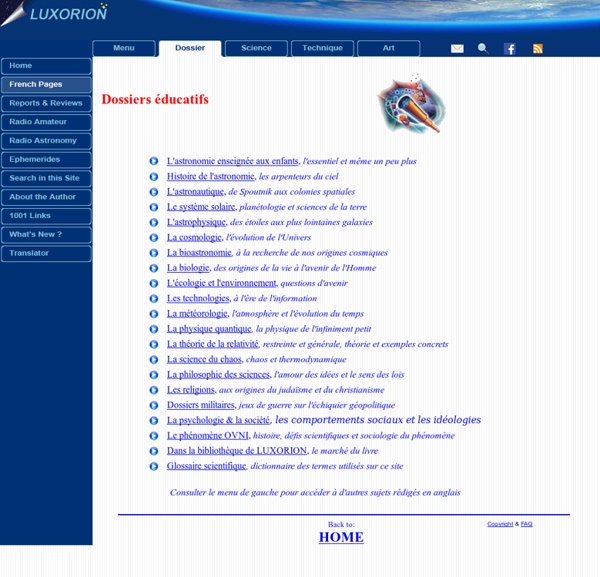



http://www.astrosurf.com/luxorion/menu-dossiers.htm
MEMO - Le site des voyages et circuits thématiques Le site des voyages thématiques Nos destinations Provence-Alpes-Côte d'Azur Rhône-Alpes Suisse Romande Nos thématiques Culture Détente En famille Gastronomie Golf Nature Patrimoine Terroir Périodes Préhistoire Antiquité Moyen Age Époque Moderne Époque Contemporaine Histoire Pays Europe Amérique Asie Afrique Moyen-Orient VIDEO: Boater Catches Explosive Volcanic Eruption, Startling Sonic Boom on Camera VIDEO: Boater Catches Explosive Volcanic Eruption, Startling Sonic Boom on Camera By Courtney Spamer, Meteorologist September 11, 2014; 4:46 AM ET Mount Tavurvur, a volcano in Papua New Guinea, erupted on Aug. 29, spewing ash and causing a shock wave and resultant sonic boom. While in a boat near the New Guinea coast, Phil McNamara caught a rare sight, the initial explosion of a volcano.
Documents in Geographic Information Systems GIS) Type to search for People, Research Interests and Universities Searching... Geographic Information Systems GIS) Securing your Raspberry PI with SSL and Simple Authentication Many of the home automation projects that I’ll be talking about on this blog will be controllable with a web browser. Most of the projects will, in fact, be controlled with simple HTTP GET requests. I do this to make it as easy as possible to control with as many methods as possible. Dr The Worldwide list of dissidents of Jean de Climont is covered by copyright. It may be downloaded for personal use only in line with applicable regulations such as laws, international treaties, CE directives and agreements. Presentation
sans titre Artist’s conception of approaching the center of the Milky Way Our solar system is inside a large galaxy known as the Milky Way. All of the stars you can see at night and several hundred billion more are all bound together gravitationally into a huge cluster called a galaxy. Most of the stars in our galaxy are far enough away that they blend together in a thin band across the sky. If you are fortunate enough to view a dark sky outside of the glare of the city lights, you will see this milky band running through the constellations Cassiopeia, Perseus, Taurus, Monoceros, Vela, Crux, Norma, Sagittarius, Scutum, Aquila, Cygnus, and Lacerta. The spiral structure of our Galaxy determined from H II regions SAO/NASA ADS Astronomy Abstract Service · Full Refereed Journal Article (PDF/Postscript)· Full Refereed Scanned Article (GIF)· References in the article· Citations to the Article (607) (Citation History) · Refereed Citations to the Article· SIMBAD Objects (131)· NED Objects (1)· Also-Read Articles (Reads History) · · Translate This Page Abstract An attempt is made to establish a coherent scheme of the spiral structure of the Galaxy on the basis of a study of H II regions and their exciting stars.
Plasma Cosmology .net Are stars powered from within, or does the power come from elsewhere? This was the question asked by Sir Arthur Eddington in the 1920s. He settled for the former, and this laid the foundation for current mainstream models. Ralph Juergens asked the question again in the 1970s, and opted for the latter. According to Juergens, stars shine because they are connected to electric circuitry within galaxies. Researchers Discover New Way to Probe Molecules and Atoms with an X-Ray Laser In this illustration, an X-ray pulse (shown in green) at SLAC’s Linac Coherent Light Source strikes a neon atom (center) as it travels from the lower left. The intense incoming light reshuffles electrons out of their original positions and into vacant positions around the atom. When the electrons fall back into place, they re-emit the X-ray light at a slightly different energy. Those X-ray light bursts trigger a chain reaction in neighboring neon atoms that amplifies the X-ray light millions of times in the same direction (shown in yellow at upper right), providing a new, highly sensitive X-ray exploration technique. Gregory M.
Cluster finds source of aurora energy boost 10 April 2013 A new study based on data from ESA's Cluster mission has revealed the importance of bursty bulk flows (BBFs) - fast streams of plasma that are launched towards Earth during the magnetic substorms that give rise to bright aurorae. By modelling these fast plasma streams using a kinetic approach, scientists have discovered that earlier studies based on magnetohydrodynamics tended to underestimate their role in the energy transfer during magnetic substorms. The new, more accurate description suggests that BBFs can carry up to one third of the total energy transferred during a substorm; in such cases, BBFs represent a major contributor to the brightening of aurorae.
Researchers Teleport 10,000 Bits of Information in 1 Second For the first time, researchers have teleported 10,000 bits of information per second from point A to point B across a distance of about six millimeters and inside a solid state circuit, similar to a computer chip. Although the accomplishment differs from teleporting mass, like a person — such as that seen on science fiction shows like Star Trek — the remarkable feat demonstrates what could be possible with a quantum computer. The scientists, from the Swiss Federal Institute of Technology (ETH) in Zurich, report their findings in this week’s issue of Nature. In their experiment, the team spaced three micron-sized electronic circuits on a seven-by-seven-millimeter computer chip. Two of the circuits worked as a sending mechanism, while the other served as the receiver. The scientists cooled the chip to near absolute zero and ran a current through the circuits.
Race for cold fusion: Nasa, MIT, Darpa and Cern peer through the keyhole Four months ago, Andrea Rossi demonstrated what he claims was a one-megawatt "Energy Catalyser" -- or E-Cat -- which produces power by cold fusion. This technology, also known as Low Energy Nuclear Reaction (LENR), had been consigned to the deepest cellar of fringe science. Now it's hammering on the cellar door, and Nasa, MIT, Darpa and Cern are among those peering through the keyhole, wondering if it should be allowed back in with respectable science.